
Uncle Tom's Cabin; or, Life Among the Lowly is an anti-slavery novel by American author Harriet Beecher Stowe. Published in two volumes in 1852, the novel had a profound effect on attitudes toward African Americans and slavery in the U.S., and is said to have "helped lay the groundwork for the [American] Civil War".
The Van Beuren Corporation was a New York City-based animation studio that produced theatrical cartoons as well as live-action short-subjects from the 1920s to 1936.
Uncle Tom's Bungalow is an American Merrie Melodies animated cartoon directed by Tex Avery, and released to theatres on June 5, 1937, by Warner Bros. The short cartoon is a parody of the 1852 novel Uncle Tom's Cabin and of the "plantation melodrama" genre of the 1930s. It contains many stereotypical portrayals of black characters. The cartoon plays off Harriet Beecher Stowe's novel in that it portrays Uncle Tom as an old man, and wooden shacks and cotton fields pervade the scenery. Director Tex Avery adds his own sense of humor and "trickster" animation, giving the classic theme a modern, humorous twist.
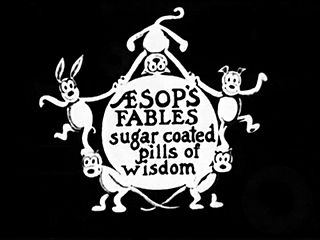
Aesop's Fables is a series of animated short subjects, created by American cartoonist Paul Terry. Produced from 1921 to 1933, the series includes The Window Washers (1925), Scrambled Eggs (1926), Small Town Sheriff (1927), Dinner Time (1928), and Gypped in Egypt (1930). Dinner Time is the first cartoon with a synchronized soundtrack ever released to the public. The series provided inspiration to Walt Disney to found the Laugh-O-Gram Studio in Kansas City, Missouri, where he created Mickey Mouse.
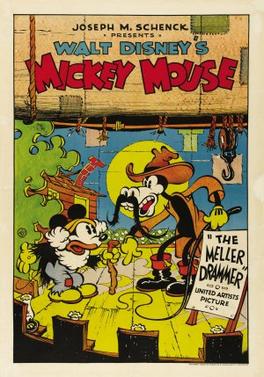
Mickey's Mellerdrammer is a 1933 American animated short film produced by Walt Disney Productions and released by United Artists. The title is a corruption of "melodrama", thought to harken back to the earliest minstrel shows, as a film short based on Harriet Beecher Stowe's 1852 anti-slavery novel Uncle Tom's Cabin and stars Mickey Mouse and his friends who stage their own production of the novel. It was the 54th Mickey Mouse short film, and the fourth of that year.

Tom show is a general term for any play or musical based on the 1852 novel Uncle Tom's Cabin by Harriet Beecher Stowe. The novel attempts to depict the harsh reality of slavery. Due to the weak copyright laws at the time, a number of unauthorized plays based on the novel were staged for decades, many of them mocking the novel's social message, and leading to the pejorative term "Uncle Tom".

A number of film adaptations of Harriet Beecher Stowe's 1852 novel Uncle Tom's Cabin have been made over the years. Most of these movies were created during the silent film era. Since the 1930s, Hollywood studios have considered the story too controversial for another adaptation. Characters, themes and plot elements from Uncle Tom's Cabin have also influenced a large number of other movies, including The Birth of a Nation (1915), while also inspiring numerous animated cartoons.

Little Eva: The Flower of the South is an Anti-Tom children's book by American writer Philip J. Cozans. Although its publication date is unknown, scholars estimated the release was either in the 1850s or early 1860s. The book follows Little Eva, the daughter of a wealthy Alabama planter. She is characterized through her kindness toward slaves as she reads the Bible to them and teaches the alphabet to slave children. On her ninth birthday, Little Eva nearly drowns, but is rescued by a slave named Sam. Her parents free Sam who decides to remain with the family because he loves them.

Uncle Tom's Cabin is a 1927 American synchronized sound drama film directed by Harry A. Pollard and released by Universal Pictures. While the film has no audible dialog, it was released with a synchronized musical score with sound effects using the Western Electric sound-on-film process. The film is based on the 1852 novel Uncle Tom's Cabin by Harriet Beecher Stowe and was the last silent version filmed.

Uncle Tom's Cabin was a 1918 American silent drama film directed by J. Searle Dawley, produced by Famous Players–Lasky Corporation and distributed by Paramount Pictures under the Famous Players–Lasky name. The film is based on Harriet Beecher Stowe's 1852 novel Uncle Tom's Cabin and George Aiken's eponymous play.

Uncle Tom's Cabin is a 1910 American silent short drama produced by the Thanhouser Company. The film was adapted by from the 1852 novel Uncle Tom's Cabin by Harriet Beecher Stowe. The plot of the Thanhouser production streamlined the actual story to portray the film over the course of a single reel. The film was released on July 26, 1910, on the same day that Vitagraph released the first reel of their own three reel version of Uncle Tom's Cabin. This prompted the Thanhouser Company to advertise against the Vitagraph film by referring to the other as being overly drawn out. The film garnered mixed, but mostly positive reception in trade publications. The film is presumed lost.

Uncle Tom's Cabaña is a 1947 American animated short film directed by Tex Avery. The short is a parody of Harriet Beecher Stowe's 1852 novel Uncle Tom's Cabin, and is Avery's second parody of the novel, the first being Uncle Tom's Bungalow in 1937 while at Warner Bros. Cartoons.

Circus Capers is a 1930 animated short film made by The Van Beuren Corporation and distributed by Pathé Exchange. The film, which featured the characters Milton Mouse and Rita, is part of the early sound cartoon series entitled Aesop's Sound Fables, though it is not based on an Aesop fable.

A Close Call is a 1929 animated short film which is part of the early sound cartoon series entitled Aesop's Sound Fables. It was produced by The Van Beuren Corporation and released by Pathé.
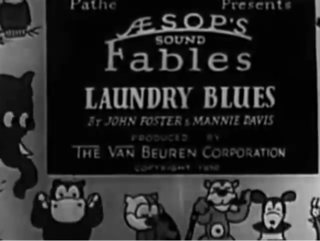
Laundry Blues is a 1930 animated short film produced by The Van Beuren Corporation and released by Pathe. The film, which takes place in a laundromat run by Chinese caricatures, was released on August 17, 1930.

Good Old Schooldays is a 1930 American film produced by The Van Beuren Corporation and released by Pathe. The film, which features Willie Jones and other animals, was directed by John Foster and Mannie Davis, with synchronization by Gene Rodemich.

The Iron Man is a 1930 animated film which was directed by John Foster and Harry Bailey. It was produced by The Van Beuren Corporation, and released by Pathé, a film distributor which had the newsreel Pathé News.
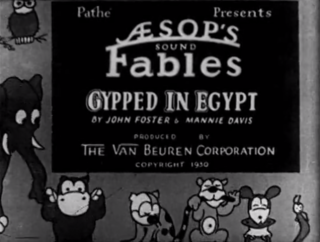
Gypped in Egypt is a 1930 animated short film directed by John Foster and Mannie Davis. The film was produced by The Van Beuren Corporation and released by Pathé, a film distributor with a newsreel titled Pathé News.
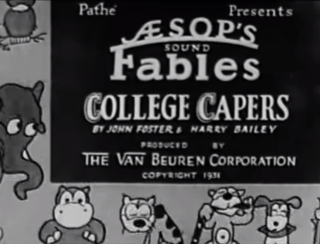
College Capers is a 1931 animated short film produced by The Van Beuren Corporation and released by the film distributor Pathé.

Western Whoopee is a 1930 animated short film directed by John Foster and Harry Bailey. It is part of the early cartoon series Aesop's Sound Fables. It was produced by The Van Beuren Corporation and released by the film company Pathé. It, like other Sound Fables at that time, features Milton Mouse and Rita, who resemble Mickey and Minnie Mouse to such an extent that Disney sued Van Beuren for the resemblance.



















